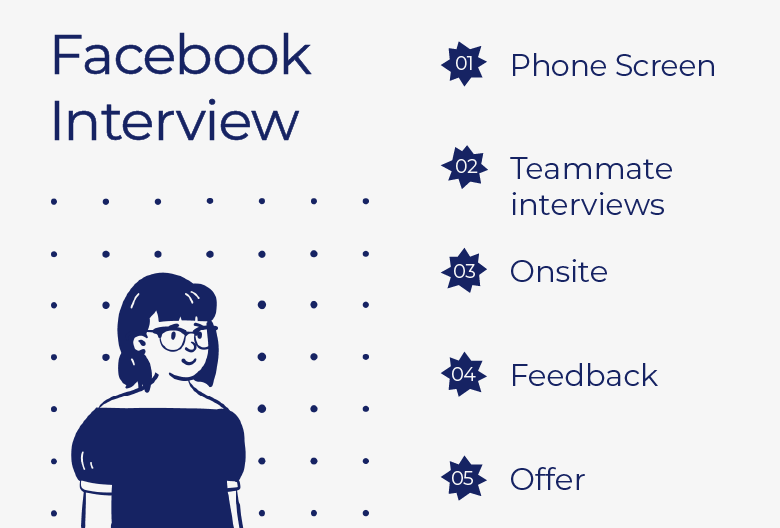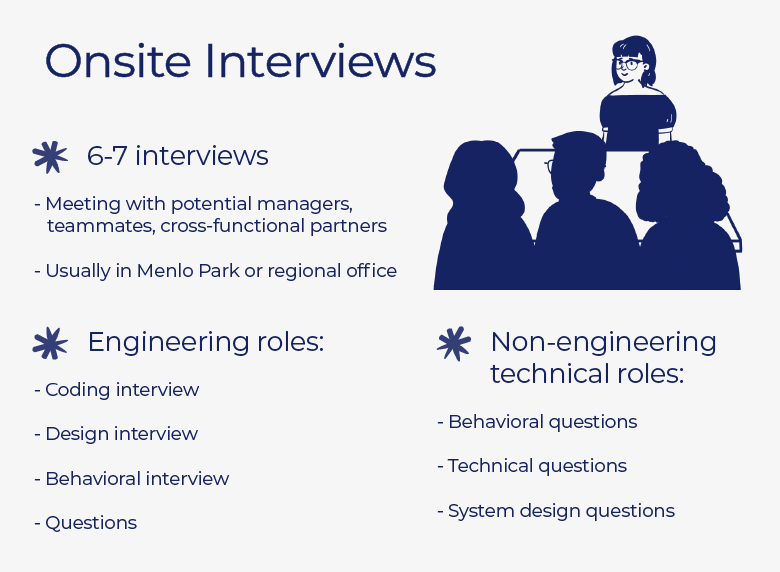Hacking the Meta Interview Process
Everything you need to know about Facebook's interview process, from phone screen to offer.

In the midst of the coronavirus pandemic, Meta announced plans for permanent remote work. If other tech giants follow suit, tech workers may see major changes to compensation structures, company culture, and other office-centric employee perks.
Pre-pandemic, Meta employees benefited from free meals, free shuttle bus service, onsite health checkups, dental care, and generous parental leave. Now, it’s uncertain whether employees will ever return to the tech giant’s sprawling campuses in Menlo Park, CA.
Meta was consistently voted one of the top places to work on Glassdoor since 2011, but dropped to #23 in 2019 on the heels of the Cambridge Analytica scandal going public. Workers also pushed back internally on some of Meta's policy decisions, such as declining to fact-check political advertisements.
That said, there’s still value in working for Meta in terms of remuneration, prestige, and learning experience. Like other FAANG companies, culture fit is a large deciding factor in the hiring process. Meta wants people who are “builders” -- entrepreneurial go-getters eager to solve problems and change the status quo.
So how do you crack the interview process at this tech giant?
How Long is the Interview Process at Meta?
Those familiar with the interview process say it depends largely on the seniority of the role you’re applying for and your background. Someone formerly employed by a competitor like Google might progress faster than a fresh grad vying for an entry-level position.
Many employees on Quora report long lulls between interview rounds (to the tune of several weeks or months), so don’t get discouraged if you don’t hear back right away.
According to Indeed, 26% of employees reported the interview process took two weeks, 23% said about a month, while 19% reported waiting longer.
The Interview Process at Meta

Phone screen (1-2 rounds)
Meta allows candidates to apply for up to three positions simultaneously. The company claims its proprietary hiring algorithms also match candidates with other Meta positions they may be suited for.
A recruiter will contact you for an initial phone screen to discuss the details of the role and what it’s like to work at Meta. They will also ask behavioral questions to assess culture fit. Bring up past projects you’ve worked on that involved building something new or disrupting the status quo. Show that you’re capable of analyzing your work by discussing what went well and coming up with areas for improvement.
👉 Discover recently asked Meta interview questions here.
For technical roles...

If you’re interviewing for a technical role, you’ll spend the first five minutes answering questions about your experience and career aspirations, then jump straight into a 30-35 minute coding challenge. You’ll be asked to solve one to two problems about data structures and algorithms using a collaborative coding platform such as CoderPad.
Each coding question is short enough to explain in a few minutes and can be solved in 10-30 minutes. If the interviewer presents a vague scenario, such as:
Ask for clarification about system requirements instead of diving right in. For example, how many users are we talking about? How will you store messages? The interviewer may add further constraints or requirements.
Brush up on data structures like lists, arrays, hash tables, hash maps, stacks, queues, graphs, trees, and heaps, as well as sorts, searches, and traversals. Also, make sure to review recursions and iterative approaches.
Meta emphasizes in its careers blog that you shouldn’t expect trick questions or estimation questions.
“We don't care how many ping pong balls can be fit in Sea World,” writes Bosmat, an engineering manager at Meta.
👉 Discover recently asked Meta interview questions here
Phone or video interviews with potential teammates
After the phone screen, recruiters delegate the remainder of the hiring process to your prospective teammates. Doing so ensures your interviewer shares your domain expertise and understands staffing requirements better than an HR generalist.
This round of interviews is designed to evaluate your interest in and ability to execute on the day-to-day work the role entails. Above all, Meta wants its employees to be happy at work.
“We want more than 70 percent of your time doing work you truly enjoy,” Janelle Gale, VP of HR, said at a 2018 industry event.
Exude passion for your chosen profession, the products and teams at Meta, and the career trajectory you’ve outlined for yourself.
"Onsite" interviews (6-7 rounds)

While this portion of the interview process was previously done on-site, it is now done remotely. This round of interviews involves potential teammates, managers, and cross-functional partners.
For non-engineering technical roles (eg: UX design, product management) the onsite interview consists of three components:
- Behavioral questions: Tests whether you are well-tempered and resilient, and if you would be a pleasant person to work with. Practice self-awareness and focus on giving answers that are honest and genuine, as Meta values these qualities.
- Technical questions: Your interviewer will be someone with your domain expertise or background. For example, if you’re a pro at building user interfaces for mobile apps, you might be interviewed by a UX designer with similar expertise.
- System design questions: Tests your ability to define the architecture, modules, interfaces, and data requirements for a system. The interviewer also wants to assess your ability to deal with vague project requirements.
For engineering roles, the onsite is structured as follows:
- Coding interview: You’ll solve a number of coding questions in a shared editor.
- Design interview (45 minutes): This phase almost never involves coding. Instead, you’ll solve problems on a whiteboard. The purpose is to assess a candidate’s ability to solve a non-trivial engineering problem and talk through the solution.
- Behavioral interview: These questions test how well you work in a team and how closely you adhere to Meta's five core values (move fast, be bold, focus on impact, be open, and build social value).
- Questions: You’ll have five minutes to ask the interviewer any questions you may have.
Feedback
Each of your interviewers will award you a score, but scores aren’t tallied up until after the onsite is over. Unlike other tech giants, this means messing up one round won’t immediately disqualify you. Remember that the feedback process can take weeks or even months.
Offer
If you pass, Meta will send you an offer detailing your remuneration and benefits. If you don’t receive an offer, you will have to wait one year to reapply.
Sample Interview Questions

Sample behavioral questions
- Tell me about your best collaboration experience.
- What do you do to stay motivated?
- How do you build relationships?
- What would you do if your interviewer didn’t show up?
- What is one project you’re proud of?
- Why do you want to work for Meta?
- What is the biggest compliment you’ve received in your current role?
- Tell me about a time you had a disagreement with your manager.
- What are Meta’s challenges in the coming years?
- What would a former coworker say about you?
👉 Practice these questions and more here.
Sample technical questions
- Design a distributed key-value caching system, like Memcached or Redis
- Design a URL shortening services like bit.ly
- Locate a substring (needle) in a string (haystack)
- Given 2 sorted arrays, find all the elements which occur in both the arrays.
- You are given two linked lists representing two non-negative numbers. The digits are stored in reverse order and each of their nodes contains a single digit. Add the two numbers and return them as a linked list.
- Find the longest increasing subsequence of a given array of integers, A.
- Given an arbitrary unweighted rooted tree that consists of N nodes, find the largest distance between two nodes in a tree.
- Say you have an array, A, for which the ith element is the price of a given stock on day i. Design an algorithm to find the maximum profit.
- Given a digit sequence, count the number of possible decodings of the given digit sequence.
- Given an array with positive numbers, find the largest subset from the array that contains elements that are Fibonacci numbers.
👉 Practice these questions and more here.
The information provided herein is for general informational purposes only and is not intended to provide tax, legal, or investment advice and should not be construed as an offer to sell, a solicitation of an offer to buy, or a recommendation of any security by Candor, its employees and affiliates, or any third-party. Any expressions of opinion or assumptions are for illustrative purposes only and are subject to change without notice. Past performance is not a guarantee of future results and the opinions presented herein should not be viewed as an indicator of future performance. Investing in securities involves risk. Loss of principal is possible.
Third-party data has been obtained from sources we believe to be reliable; however, its accuracy, completeness, or reliability cannot be guaranteed. Candor does not receive compensation to promote or discuss any particular Company; however, Candor, its employees and affiliates, and/or its clients may hold positions in securities of the Companies discussed.
